Wednesday 25 August, 2010, 04:10 - Pirate/Clandestine
Posted by Administrator
Back in October 2009, Wireless Waffle brought to your attention the HF (short-wave) monitoring data produced on a quarterly basis by the ITU. Within these reports were a number of short-wave pirate stations and the original list of stations brought a lot of interest from these stations, both to see who had been 'caught' and to see how close the ITU had gotten to identifying their exact location. Based on the e-mails that were received following the article, it seems like some had hit the nail a little too closely on the head for comfort.Posted by Administrator
To see how the ITU were getting along, and who had been spotted more recently, a trawl of the montoring reports from January to June 2010 has been conducted and the results presented below. Those stations whose name is shown in CAPITALS were directly identified by the monitoring station concerned. Those in lower case have been identified using the various on-line blogs that report pirate reception.
| Date | Time (UTC) | Freq (kHz) | Monitoring Station | Location | Station | |
|---|---|---|---|---|---|---|
| 03 Feb 10 | 0600-0600 | 4025 | Berlin, Germany | UK | Laser Hot Hits | |
| 23 Feb 10 | 0000-0630 | 4025 | Tarnok, Hungary | Laser Hot Hits | ||
| 23 Feb 10 | 1830-2359 | 4025 | Tarnok, Hungary | Laser Hot Hits | ||
| 21 Apr 10 | 1830-2400 | 4025 | Berlin, Germany | Laser Hot Hits | ||
| 02 May 10 | 0600-2359 | 4025 | Rambouillet, France | 0W10 52N01 (Baldock, UK!) | Laser Hot Hits | |
| 23 May 10 | 0000-0630 | 4015 | Tarnok, Hungary | Laser Hot Hits | ||
| 16 May 10 | 1900-2212 | 5814.7 | Rambouillet, France | 0E17 52N45 (King's Lynn, UK) | Radio Telstar South | |
| 16 May 10 | 0700-0915 | 5815 | Rambouillet, France | 6E11 52N30 (Zwolle, Netherlands) | Orion Radio | |
| 27 Jun 10 | 0630-0820 | 5820 | Tarnok, Hungary | Orion Radio | ||
| 11 Apr 10 | 0854-0908 | 6203 | Vienna, Austria | Radio Scotland International | ||
| 09 Feb 10 | 1048 | 6210.2 | CCRM, Belgium | Netherlands | MISTI RADIO | |
| 10 Jan 10 | 1818-2246 | 6220 | El Casar, Spain | 11E24 44N27 (Bologna, Italy) | Mystery Radio | |
| 20 Jan 10 | 1812-2350 | 6220 | El Casar, Spain | 11E24 44N27 (Bologna, Italy) | Mystery Radio | |
| 30 Jan 10 | 2002 | 6220 | Baldock, UK | 10E0 43N50 (Pisa, Italy) | MYSTERY RADIO | |
| 28 Feb 10 | 1100-1137 | 6220 | Vienna, Austria | 11E0 44N0 (Prato, Italy) | RADIO MARABU | |
| 06 Mar 10 | 1800-2350 | 6220 | El Casar, Spain | 11E24 44N27 (Bologna, Italy) | Mystery Radio | |
| 21 Mar 10 | 2012-2355 | 6220 | El Casar, Spain | 11E24 44N27 (Bologna, Italy) | Mystery Radio | |
| 06 Apr 10 | 1852-1917 | 6220 | Vienna, Austria | Italy | MYSTERY RADIO | |
| 10 Apr 10 | 1900-2359 | 6220 | El Casar, Spain | 11E24 44N27 (Bologna, Italy) | MYSTERY RADIO | |
| 13 Jun 10 | 1730-1800 | 6220 | Klagenfurt, Austria | 12E0 43N0 (Perugia, Italy) | Mystery Radio | |
| 14 Jun 10 | 1700-1900 | 6220 | Rambouillet, France | 10E43 43N45 (Prato, Italy) | MISTERY RADIO | |
| 15 Jun 10 | 0700-0800 | 6255 | Rambouillet, France | Netherlands | Cool AM | |
| 19 Jun 10 | 1530-1645 | 6374.1 | Rambouillet, France | 4E13 51N59 (Den Haag, Netherlands) | Radio Baken 16 | |
| 09 Feb 10 | 0944 | 6299.2 | CCRM, Belgium | RADIO RAINBOW | ||
| 30 Apr 10 | 1918-2005 | 6375 | Vienna, Austria | Netherlands | Radio Relmus | |
| 09 Feb 10 | 0914 | 6376.6 | CCRM, Belgium | Netherlands | RADIO DUTCH WING | |
| 20 Jun 10 | 1015-1600 | 6399.9 | Rambouillet, France | 1W45 51N21 (Marlborough, UK) | Laser 558 relay | |
| 11 Mar 10 | 1815-2200 | 6870 | El Casar, Spain | 9E7 45N18 (Milan, Italy) | RADIO PLAYBACK INT | |
| 11 Apr 10 | 1500-1700 | 6959.9 | Rambouillet, France | 4E39 51N41 (Breda, Netherlands) | Radio Jan Van Gent | |
| 03 Jan 10 | 0800 | 7610 | El Casar, Spain | Italy | RADIO AMICA | |
| 10 Apr 10 | 0600-2115 | 7610 | Rambouillet, France | 12E56 43N55 (Pesaro, Italy) | RADIO AMICA | |
| 11 Apr 10 | 0530-0600 | 7610 | Rambouillet, France | 12E56 43N55 (Pesaro, Italy) | RADIO AMICA | |
| 10 Apr 10 | 1247-1407 | 7610 | Vienna, Austria | 11E30 44N30 (Bologna, Italy) | RADIO AMICA |
Please be assured that it is not our intention to name and shame these stations in any way, nor is the Wireless Waffle team opposed to hobby broadcasting (for want of a better word) but we do believe that the stations concerned should be aware that their location may not be as secret as they had hoped.
The question of how accurate these measurements are is a good one. The level of concern that seemed to arise from the previous list suggests that they may be relatively good. However, let's take a real example. There are 10 measurements relating to Mystery Radio. Of these, five different locations are logged. The map below shows the position of these loggings.
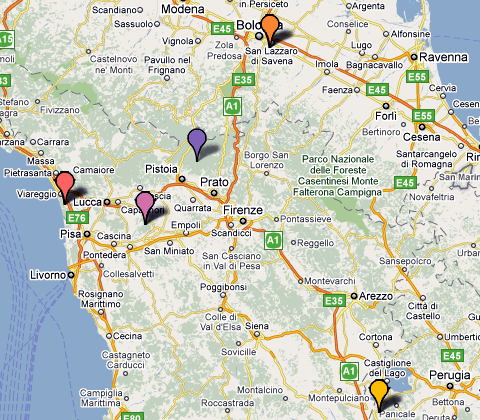
 The distance between the closest of all these measurements is around 20 miles (32 km). It is possible that this is the best resolution that some of the monitoring stations can achieve. At this kind of resolution, a ground-based receiver would be unlikely to hear the transmitter. Ground wave signals would not travel this far, and it is the ground wave signal which is required for a person on the ground to be able to 'home in' on the location of a transmitter.
The distance between the closest of all these measurements is around 20 miles (32 km). It is possible that this is the best resolution that some of the monitoring stations can achieve. At this kind of resolution, a ground-based receiver would be unlikely to hear the transmitter. Ground wave signals would not travel this far, and it is the ground wave signal which is required for a person on the ground to be able to 'home in' on the location of a transmitter. So should pirate radio stations be concerned about being tracked down as a result of the work of the ITU. From the evidence above, it seems that this data alone is probably insufficient to allow a station's location to be identified in one simple move. However, if you are running one of these stations and the location which is shown is more accurate than those for Mystery Radio - and certainly if its within 5 km at which point a man on the ground would be able to track you down - perhaps it's time to up sticks and find a new site!
add comment
( 1936 views )
| permalink
| 



 ( 3.1 / 137078 )
( 3.1 / 137078 )




 ( 3.1 / 137078 )
( 3.1 / 137078 )
Tuesday 10 August, 2010, 05:17 - Broadcasting
Posted by Administrator
One of the most common questions that the Wireless Waffle team are asked by those setting up radio transmitters is, "How much power do I need to cover an area X miles wide?". Such a question is virtually unanswerable as there are so many factors to take account of including the frequency of operation, the topography of the area, the kind of structures (buildings, trees) which are in the required coverage area, what kind of receivers people are using and much more. The observant will note that these factors are not ones which can necessarily be changed by the person operating the transmitter - unless they fancied chopping down a forest for example. What can be changed at the transmitting site are two relatively simple factors: the height of the antenna, and the power of the transmitter.Posted by Administrator
Such discussions therefore end up focussing on how high the antenna needs to be and what power the transmitter should be. But which is most effective in increasing coverage: height or power?
Let's tackle height first. Assuming we are trying to provide a signal over the earth and that there are no obstacles at all and that the earth has no undulations (hills and so on), then the range of a transmitter can easily be calculated from a simple line-of-sight rule. This tells us that for a particular height above the ground, the horizon (and thus the edge of the coverage area) will be a specific distance away. One oddity in this is that radio signals tend to get defracted a little by the Earth's atmosphere which has the effect of making the planet appear slightly less curved and thus extends the radio horizon about a third beyond the optical horizon. The chart below shows the optical and radio horizons for a transmitting antenna mounted at a certain height.
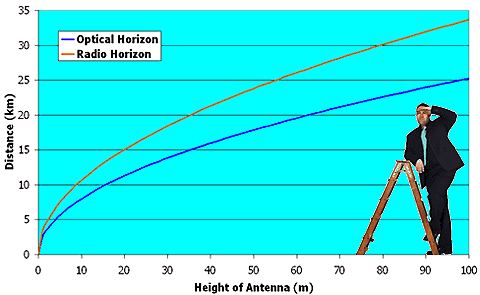
With an antenna about 10 metres above the ground, the radio horizon is about 10km away. If the height of the antenna is increased to 50 metres, the radio horizon increases to about 24 km - a very healthy improvement. It's perhaps worth noting that 'height above ground' could be generated by raising the height of the antenna, or by mounting it on top of heigh point (eg a hill).
Increasing the transmitter power also increases coverage, but not in quite the same way. Getting signals much beyond the radio horizon relies on various odd propagation techniques including refraction, defraction and scatter. In free space, increasing the power by a factor of 2 will increase the distance at which the signal is of equal strength by the square root of 2. So, if the signal is 30 dB at a distance of 10km, increasing the power by a factor of 2 will move the point at which the signal is 30 dB to a point approximately 14km away from the transmitter. Sadly, the Earth is not generally a 'free space' environment and signals fall away much quicker than this, even before the horizon is reached. The chart below shows a simulation of coverage for different transmitter powers, assuming an antenna height of 20 metres.
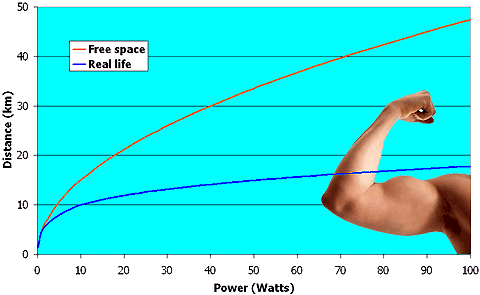
The distance to the radio horizon for a 20 metre heigh aerial is 15 km and in 'free space', in this example, this is reached by a power of 10 Watts. For the 'real life' example, 10 Watts only achieves a distance of around 10 km because of the fact that the Earth is not a free space environment. To achieve 15 km in 'real life' requires a power of nearer 50 Watts. What is immediately clear is that enormous increases in power are required to extend coverage. Even with 100 Watts, in our theoretical example, the distance acheived is still less than 20 km.
Increasing the height of the transmitting antenna is therefore, theoretically, a much more effective way of increasing coverage than turning up the power. Of course, it's not always possible to put up a high antenna, and in this situation more power is clearly better, but in general height wins every time. To show the difference, the map below (made using Radiomobile) shows the coverage for a transmitter nominally located in the centre of Oxford. It's animated (oo-err!) and cycles through the coverage which would be acheived for:
* A 10 Watt transmitter with an antenna height of 10 metres
* A 40 Watt transmitter with an antenna height of 10 metres
* A 10 Watt transmitter with an antenna height of 20 metres
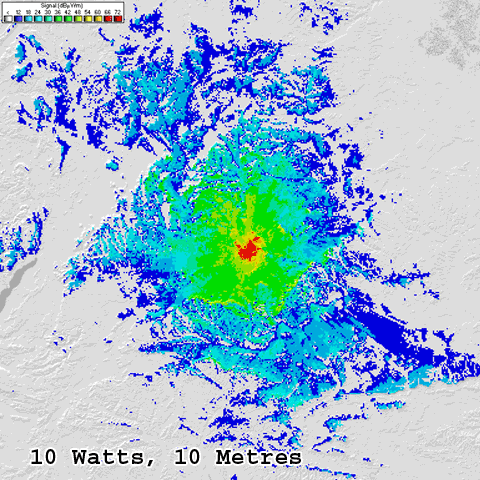
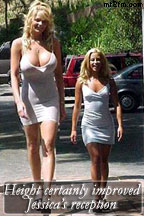 The coverage achieved in the latter two cases is very similar, however in the map with the higher antenna, the coverage is more 'solid' than that with higher power. If this were a radio station, the higher antenna would provide a more reliable signal, especially for people on the move, than the lower antenna with higher power. The extent of the advantage of height over power means that it is generally more beneficial to identify an elevated transmitter site towards the edge of an area where coverage is required, rather than settle for one which is nearer the centre but lower. A transmitter on a hill overlooking a town will provide more solid coverage in the town for the same transmitter power than a site in a town centre. Hopefully, those now considering how best to maximise their coverage will think beyond Watts and consider that factor well understood by estate agents, location, location, location.
The coverage achieved in the latter two cases is very similar, however in the map with the higher antenna, the coverage is more 'solid' than that with higher power. If this were a radio station, the higher antenna would provide a more reliable signal, especially for people on the move, than the lower antenna with higher power. The extent of the advantage of height over power means that it is generally more beneficial to identify an elevated transmitter site towards the edge of an area where coverage is required, rather than settle for one which is nearer the centre but lower. A transmitter on a hill overlooking a town will provide more solid coverage in the town for the same transmitter power than a site in a town centre. Hopefully, those now considering how best to maximise their coverage will think beyond Watts and consider that factor well understood by estate agents, location, location, location.Thursday 1 April, 2010, 08:04 - Pirate/Clandestine
Posted by Administrator
Posted by Administrator
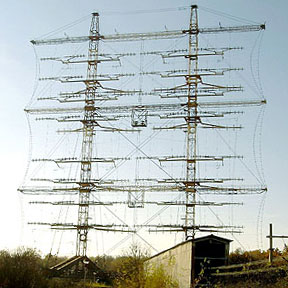 There is endless speculation on the internet as to what became of the many pirate radio ships which sailed the seven seas (or the North Sea more specifically) in the bygone era. Wireless Waffle can exclusively reveal the final resting home of one of these infamous nafarious vessels, having been tipped off by a Government source who wishes to remain anonymous. 'Dave Herrish' for want of a better name (and a complete lack of imagination on our part) has informed us that the rigging that adorned the pirate ship 'The Ross Communidel Amigocado' was removed from the hull at a secret military shipyard somewhere on the southern northern Europe coast and transported, piece by piece, to the facilites of Radio Bulgaria where it was re-assembled and used as a mast for their short-wave monitoring station.
There is endless speculation on the internet as to what became of the many pirate radio ships which sailed the seven seas (or the North Sea more specifically) in the bygone era. Wireless Waffle can exclusively reveal the final resting home of one of these infamous nafarious vessels, having been tipped off by a Government source who wishes to remain anonymous. 'Dave Herrish' for want of a better name (and a complete lack of imagination on our part) has informed us that the rigging that adorned the pirate ship 'The Ross Communidel Amigocado' was removed from the hull at a secret military shipyard somewhere on the southern northern Europe coast and transported, piece by piece, to the facilites of Radio Bulgaria where it was re-assembled and used as a mast for their short-wave monitoring station.Situated between Varna and Dolni Chiflik the antennas are now used as a high gain array for the purposes of intercepting both civil and military radio traffic. But, twice a year, in what must be one of the most ironic celebrations in Europe, the station is opened to the public whereupon bunting and other maritime flags are fastened and festooned to the antennas and small children are allowed to climb up and pretend to be seafaring pirates.
Unbeknownst to many of these children, the Bulgarian phrase for 'I am a pirate', which is 'Лиц ентура дёка ролаян' transliterates as 'lits entura dyohka rolayan' (try saying it out loud), which is often heard being screeched loudly across the countryside accompanied by the ringing of ships bells. Ding dong!
Friday 1 January, 2010, 00:14 - Pirate/Clandestine
Posted by Administrator
Regulars to the pages of Wireless Waffle will realise that we have an inate (or should that be 'inert') fascination with short wave radio. And nothing is more mysterious and intriguing on short wave than the many spy broadcasts which usually take the form of a string of numbers or letters read out in a mechanical fashion by a pre-recorded male or female voice. A bit like the speaking clock for spooks.Posted by Administrator
 One of the most famous spy stations, the Lincolnshire Poacher (which was allegedly broadcast from Cyprus), ceased transmissions in 2008 and it rumour has it that its sister station, Cherry Ripe (latterly broadcast from Australia) also ceased transmissions towards the end of 2009. Which leaves fans of these funky but furtive broadcasts with a big hole in their social calendar (not that such fans had much of a social calendar to begin with).
One of the most famous spy stations, the Lincolnshire Poacher (which was allegedly broadcast from Cyprus), ceased transmissions in 2008 and it rumour has it that its sister station, Cherry Ripe (latterly broadcast from Australia) also ceased transmissions towards the end of 2009. Which leaves fans of these funky but furtive broadcasts with a big hole in their social calendar (not that such fans had much of a social calendar to begin with).But all is not lost. Thanks to the Conet project and web designer Kevan Davis fans can now enjoy:
* Number Station Bingo
This excellent game will keep you occupied (but not in the same way as the US forces in Iraq) for literally minutes. If you win, it is customary to shout 'Badabingo, green stick in the green hole' though for security reasons we obviously cannot explain why this is so.


